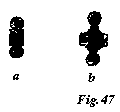CONSTRUCTION XVII. FILLING OF APERTURE 231
after the fashion of cast-iron, as at C. You have still two triangular spaces occurring in an important part of your window, g g, which, as they are very conspicuous, and you cannot make them uglier than they are, you will do wisely to let alone:-and you will now have the west window of the cathedral of Winchester,1 a very perfect example of English Perpendicular. Nor do I think that you can, on the whole, better the arrangement, unless, perhaps, by adding buttresses to some of the bars, as is done in the cathedral of Gloucester; these buttresses having the double advantage of darkening the window when seen from within, and suggesting, when it is seen from without, the idea of its being divided by two stout party walls, with a heavy thrust against the glass.
§ 17. Thus far we have considered the plan of the tracery only: we have lastly to note the conditions under which the glass is to be attached to the bars; and the sections of the bars themselves.
These bars we have seen, in the perfect form, are to become shafts; but, supposing 
1 [For other references to Winchester Cathedral, see Seven Lamps, Vol. VIII. p. 188 n.; St. Mark’s Rest, § 21.]
[Version 0.04: March 2008]